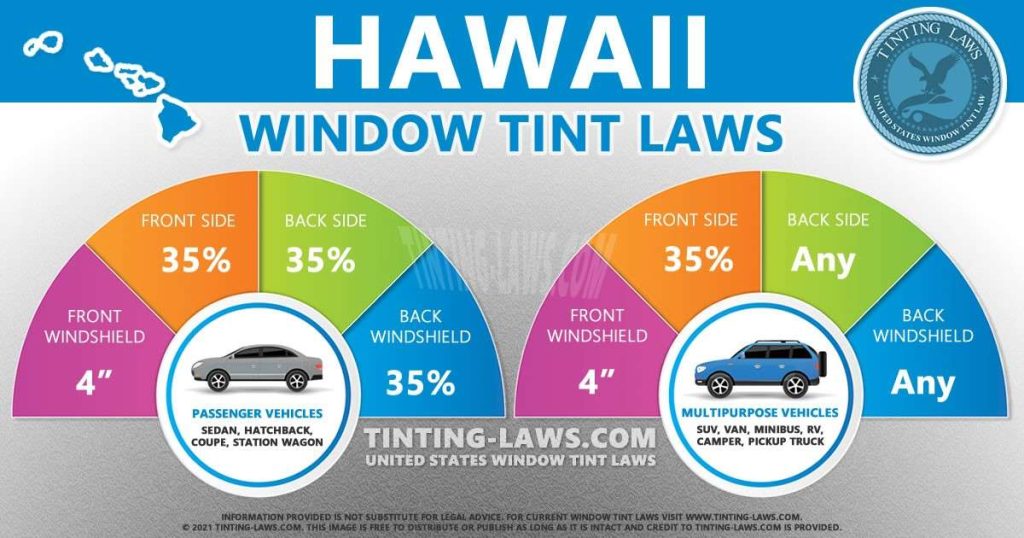Hawaii Window Tinting Laws
Car window tinting laws in Hawaii were enacted in 1989.
We have provided all the necessary information about your car’s window tint, including how dark or reflective the tint is allowed in your state.
There are also additional car window tinting rules and regulations in Hawaii so make sure you read all about it below.
Window tint darkness in Hawaii
The percent of visible light allowed through your car windows is called VLT: Visible Light Transmission.
The percentage of light allowed through your film and glass in Hawaii is very specific and different for sedan cars and SUV cars or vans.
Tint darkness for sedans:
- Windshield: Non-reflective tint is allowed on the top 4 inches of the windshield.
- Front Side windows: Must allow more than 35% of light in.
- Back Side windows: Must allow more than 35% of light in.
- Rear Window: Must allow more than 35% of light in.
Tint darkness for SUV and vans:
- Windshield: Non-reflective tint is allowed on the top 4 inches of the windshield.
- Front Side windows: Must allow more than 35% of light in.
- Back Side windows: Any darkness can be used.
- Rear Window: Any darkness can be used.
Window tint installer must issue a certificate of compliance to customer. Certificate must be stored in vehicle at all times.
Window tint reflection in Hawaii
Window tint can reflect incoming light and reduce glare and heat.
Hawaii window tint law permits a certain window reflection when using a tint so make sure you pay attention to this as well.
Tint reflection for sedans:
- Front Side windows: No metallic or mirrored appearance.
- Back Side windows: No metallic or mirrored appearance.
Tint reflection for SUV and vans:
- Front Side windows: No metallic or mirrored appearance.
- Back Side windows: No metallic or mirrored appearance.
Other Hawaii window tint rules and regulations:
Hawaii does have several other important laws, rules and regulations pertaining to window tinting. They include the following:
- Side Mirrors: Dual side mirrors are required if back window is tinted.
- Restricted Colors: No specified colors of tint are banned.
- Tint Variance: 6%.
- Certificates: Film manufacturers are not required to certify the film they sell in this state.
- Stickers: No sticker to identify legal tinting is required by Hawaii law.
- Medical Exceptions: Hawaii law does NOT allow medical exemptions that would allow you use special tint.
- Penalties: $250 – $500 for vehicle owners, and $500 – $1000 for businesses.
Keep in mind that Hawaii tinting laws and regulations may be interpreted differently in your county or place of residence.
We always recommend double-checking our information with your local DMV or law enforcement authorities.

Our information about window tint laws in Hawaii was last updated in 2024.
Tinting laws in Hawaii were enacted in 1989.
In case any of our info provided is not up to date or correct be sure to contact us so we can fix it. Thanks!
Trusted industry leader in providing accurate window tint laws. Share with confidence:
State of Hawaii Info
Hawaii is the most recent of the 50 U.S. states (joined the Union on August 21, 1959), and is the only U.S. state made up entirely of islands.
It is the northernmost island group in Polynesia, occupying most of an archipelago in the central Pacific Ocean.

Hawaii’s diverse natural scenery, warm tropical climate, abundance of public beaches, oceanic surroundings, and active volcanoes make it a popular destination for tourists, (wind)surfers, biologists, and vulcanologist alike.
Due to its mid-Pacific location, Hawaii has many North American and Asian influences along with its own vibrant native culture.
Hawaii has over a million permanent residents along with many visitors and U.S. military personnel. Its capital is Honolulu on the island of Oʻahu.
Capital: Honolulu
Population: 1,392,313
Area: 10,931 sq mi (28,311 km2)
Cities in Hawaii: Honolulu, East Honolulu, Pearl City, Hilo, Kailua, Waipahu, Kaneohe, Mililani Town, Kahalui, Ewa Gentry, Mililani Mauka, Kihei, Makakilo, Wahiawa, Schofield Barracks, Wailuku, Kapolei, Ewa Beach, Royal Kunia, Halawa, Waimalu, Waianae, Nanakuli, Kailua, Lahaina, Waipio, Hawaiian Paradise Park, Kapaa, Kalaoa, Kaneohe Station, Maili, Aiea, Waimea, Waihee-Waiehu, Ahuimanu, Holualoa, Ocean Pointe, Makaha, Haiku-Pauwela, Pukalani, Waikele, Napili-Honokowai, Makawao, Hickam Housing, Lihue, Kula
Counties in Hawaii: Hawaii, Maui, Kalawao, Honolulu, Kauai
Tint law references:
Hawaii Revised Statutes section 291-21.5: Regulation of motor vehicle sun-screening devices; penalty